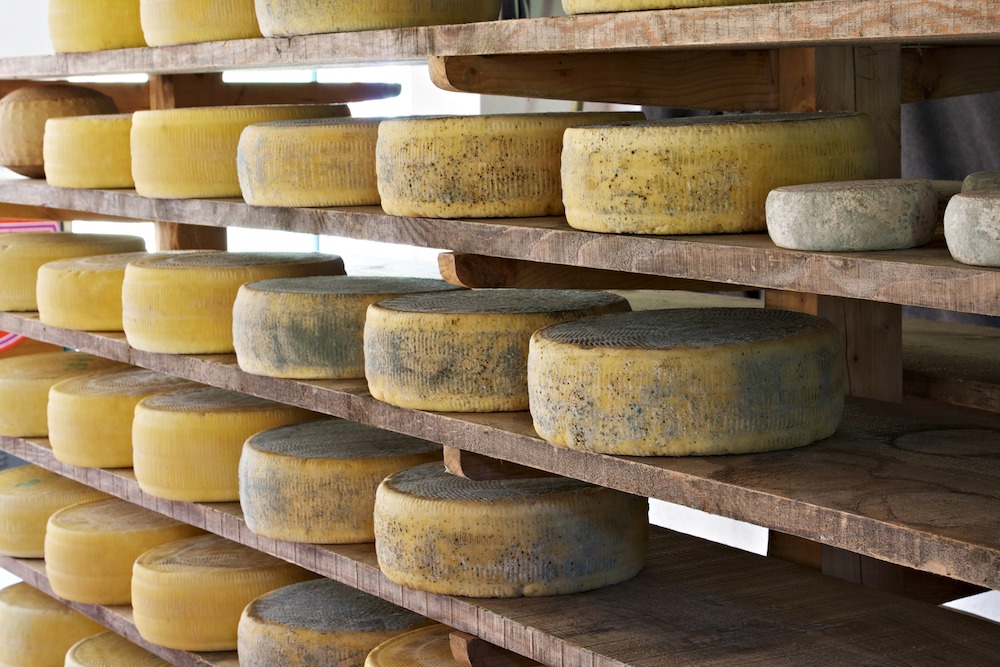- The wise pizza maker is always experimenting with a variety of cheeses in search of that perfect signature pizza.
- Flavor-boosting cheeses to consider include aged Asiago, blue cheese, ricotta, feta, aged provolone and Monterey Jack.
Related: Hike up your pizza’s wow factor with these unique and unforgettable cheese blends
There’s a cheese for every taste and every occasion. While mozzarella, with its adaptable flavor and gooey texture, reigns supreme in pizza applications, many customers crave more adventurous alternatives, and the wise pizza maker is always experimenting with a variety of cheeses in search of that perfect signature recipe. If you’re looking to offer your customers more artisanal options, these six versatile cheeses—recommended by the experts at the California Milk Advisory Board—will boost your pizza’s flavor profile while keeping food costs down.
Aged Asiago: Keep Behind the Counter
In its American version, this whole-milk cheese is a hard, grating cheese, a far cry from its fresh and supple Italian ancestor. Asiago can be compared to Parmesan as a crumbly, dry cheese perfect for finishing off a pizza, pasta or practically any Italian dish. Asiago differs from Parmesan, however, in its texture, which is creamier and similar to an aged cheddar. And, unlike Parmesan, it’s not a cheese you’d leave out on tables; Asiago’s higher fat content prevents it from ever getting hard and dry enough to stay in shakers without gumming up, and it’s not cheap.
You’ll want to use Asiago sparingly behind the counter and make sure it doesn’t have to compete with other flavors. Sprinkle a little aged Asiago on a pizza just after the pie is fully cooked to add a unique aromatic and textural quality.
Blue Cheese: A Little Dab’ll Do Ya
Blue cheese currently ranks as the fifth most common cow-milk cheese on pizzeria menus in the United States, according to Technomic’s MenuMonitor. Its potent odor and occasional foreign spelling (bleu) reminds one of France, its country of origin. Blue is a sister cheese to Gorgonzola, whose signature blue mold originally spawned from bread yeast that transferred to the cheese through the air. In Italy, Gorgonzola developed from wheat bread yeast, while rye bread, which is much more common in France, yielded blue cheese.
Blue cheese’s most distinguishing feature today is its sharp potency, as opposed to the earthier, creamier Gorgonzola. Both pair well with sweet and salty ingredients such as fruit, nuts and cured ham.
Related: Talking pizza cheeses with Mark “The Cheese Dude” Todd
Chef Mark Todd (also known as The Cheese Dude) from the California Milk Advisory Board suggests using blue cheese in a spread. “Mix it with whatever cream you have in stock,” he says. “You can even add a little extra blue cheese to your blue cheese dressing. Keep in mind, though, that you must use mozzarella on top to keep everything in place. Dressing will have a tendency to run, and you really only need a small amount to get the flavor you want.”
For topping a blue cheese pizza base, Todd suggests a hearty meat, such as sausage or beef; nuts or salad greens; or seasonal fruits for an innovative dessert pizza.

Ricotta: All About the Texture
Affordable and plentiful, ricotta is a super-soft, fresh cheese historically produced from leftover whey after mozzarella cheese production. The texture can be compared to cottage cheese, with smaller curds and a sweeter, milkier taste. Ricotta is found throughout Italian cuisine and comes in three varieties: whole-milk, part-skim and fat-free. The whole-milk variety is excellent for a lasagna or cannelloni, while part-skim is used primarily for ravioli to keep the cheese from running. Fat-free, meanwhile, can be used to crumble onto salads. Unfortunately, the fat-free variety doesn’t melt, so it doesn’t look as great on a pizza.
But ricotta isn’t about appearance—it’s about texture, and it carries flavors wonderfully. Mix it with chives, garlic or salt to transmit a burst of creamy flavor. There’s just one caveat: Ricotta is a moist cheese, so it can make your pizza crust droopy. It typically works best on a pizza that doesn’t have a tomato sauce base. Try applying your mixture with a pastry sleeve to keep portions small and consistent.
Feta: Bang for Your Buck
Reasonably priced and loaded with flavor, feta goes a long way on pizzas and in salads. It’s most commonly known as an exotic, pungent Greek cheese, but it is, in fact, the same stuff as your basic bland farmer’s cheese. The key difference is the use of an accelerant called lipase, which speeds up the aging process. Lipase gives feta its defining sharp taste. Ever faithful to its heritage, this cheese is commonly used on Greek or Mediterranean pizzas and appetizers.
If you’re feeling adventurous, take stock of your Mediterranean toppings—such as roasted peppers, olives, pepperoncini and red onions—and combine them with feta. Chef Todd suggests combining feta with green olives and julienned prosciutto (which is more affordable than prosciutto in large slices). He also recommends a tossed watermelon, feta and mint salad topped with cracked black pepper for a summertime treat. The ingredients are abundant and cheap in season, Todd notes, and make a refreshing dish.
Aged Provolone: The Perfect Blend
Aged provolone is a firm, elastic, fairly hard cheese that’s perfect for use in a cheese blend with mozzarella. It’s dry but high in fat, which makes it great for melting as a 5%, 10% or 15% blend with standard pizza cheese. Its flavor bite comes from the addition of lipase, which gets stronger as the cheese ages. One or two years of aging is standard with aged provolone—you probably don’t want to age it for more than three years. It’s also shreddable and has an extended shelf life. Best of all, it packs a flavorful punch and livens up any mozzarella dish.
Monterey Jack: Carry the Flavor
Often overlooked, Monterey Jack doesn’t have a strong flavor of its own, but it carries other flavors beautifully in varieties such as pepper jack, rosemary jack or even habanero jack. It has a creamy, buttery, mellow flavor with no biting edge. It’s a noncontroversial little cheese that’s palatable to nearly everyone.
Since the American palate is turning toward spicy flavors, according to the California Milk Advisory Board, pepper jack is a fine way to add a little heat to your pizza. Pepper jack can be used for a Mexican-style pizza or on salads. It’s great in a blend, too, because its high fat content allows the cheese to melt and flow beautifully on a pizza without browning.
This article by Missy Green Assink originally appeared in the December 2014 issue of PMQ Pizza Magazine.





